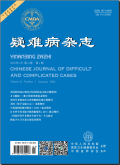疑难病杂志2024,Vol.23Issue(5):552-556,5.DOI:10.3969/j.issn.1671-6450.2024.05.009
巨大侵袭性垂体腺瘤患者肿瘤切除程度和肿瘤进展的相关因素分析
Analysis of factors associated with the extent of tumor resection and tumor progression in patients with giant invasive pituitary adenomas
摘要
Abstract
Objective To study the relevant factors affecting the degree of tumor resection and tumor progression in patients with giant invasive pituitary adenoma treated surgically.Methods One hundred and twenty patients with giant invasive pituitary adenomas admitted to the Department of Neurosurgery of the Shijiazhuang People's Hospital from March 2017 to March 2021 were retrospectively selected,and were classified into 75 cases of near-total resection and total resection group,and 45 cases of sub-total resection group according to the type of surgery.According to their tumor progression,they were divided into 20 cases in the tumor progression group and 100 cases in the tumor non-progression group.The clinical data of the patients were analyzed by multifactorial analysis,and the above Logistic regression analysis was used to analyze the independent risk factors affecting the degree of tumor resection and tumor progression in patients with giant in-vasive pituitary adenoma treated by surgery.Results Univariate analysis showed that the proportion of patients with previ-ous surgical treatment,previous radiotherapy,Knosp grade 3-4,maximumdiameter of tumor>5 cm,tumor invasion into the posterior cranial fossa,inhomogeneous enhancement of MR lesions,hard and tough tumor texture,and lobulated or clumped tumor was higher in the subtotal resection group than in the subtotal resection and total resection groups(χ2/P= 9.391/0.002,6.487/0.011,5.562/0.018,9.700/0.007,5.820/0.016,10.901/0.001,14.959/<0.001,and 14.415/0.001);the percentage of patients with mitosis phase,Ki-67 index≥3%,and the degree of tumor resection as subtotal resection were all higher in the tumor progression group than in the tumor non-progression group(χ2/P=5.608/0.018,4.631/0.031,6.334/0.042).The results of multifactorial unconditional Logistic regression analysis showed that the texture of the tumor as hard and tough,and the Knosp grade of the tumor as grade 3-4 were independent risk factors affecting the extent of tumor resection in patients with giant invasive pituitary adenomas[OR(95%CI)=1.441(1.042-1.991),1.592(1.040-2.436),both P<0.05];the degree of tumor resection as subtotal resection,and nuclear schizophrenia visible on pathological examination were all independent risk factors affecting tumor progression in patients with hugely aggressive pituitary adenomas[OR(95%CI)=1.675(1.141-2.455),1.422(1.074-1.882),both P<0.05].Conclusion Tumor texture is hard and tough,tumor Knosp grade 3-4 are inde-pendent risk factors affecting the degree of tumor resection in patients with giant invasive pituitary adenoma;tumor resec-tion degree is subtotal resection,and nuclear schizophrenia can be seen in pathological examination are independent risk factors affecting the progression of the tumor in patients with giant invasive pituitary adenoma.关键词
垂体腺瘤,巨大侵袭性/手术治疗/肿瘤切除程度/肿瘤进展/相关因素Key words
Pituitary adenoma,giant invasive/Surgical treatment/Degree of tumor resection/Tumor progression/Related factors分类
临床医学引用本文复制引用
檀浩鹏,屈浙,田军,王坤,李建华..巨大侵袭性垂体腺瘤患者肿瘤切除程度和肿瘤进展的相关因素分析[J].疑难病杂志,2024,23(5):552-556,5.基金项目
石家庄市科学技术研究与发展指导计划(171461563) Shijiazhuang Science and Technology Research and Development Guidance Plan(171461563) (171461563)

